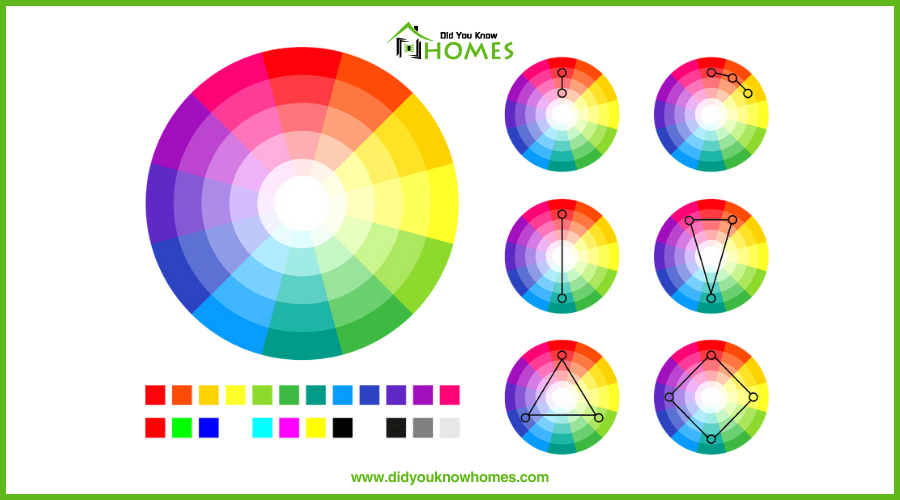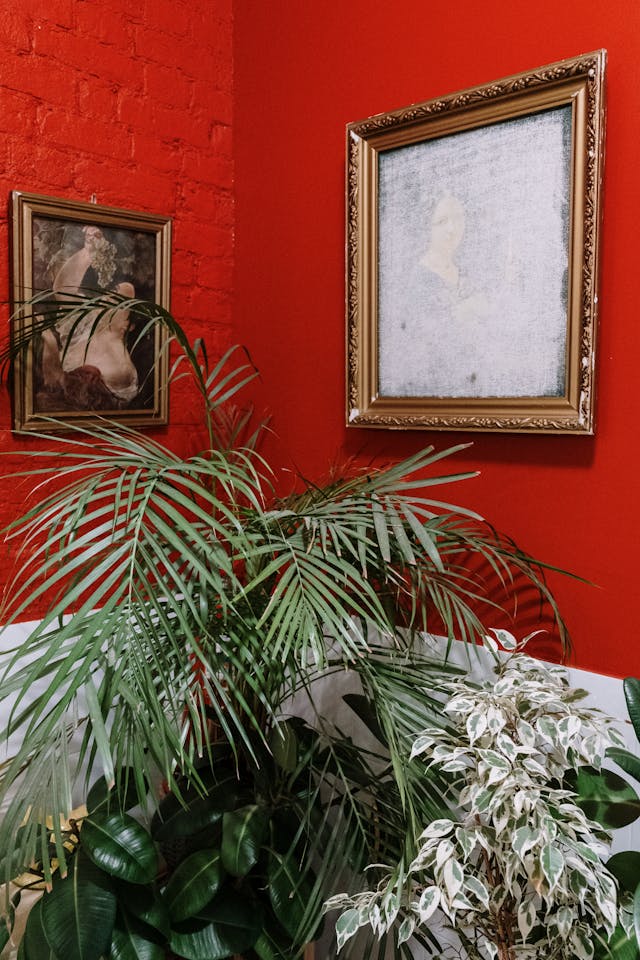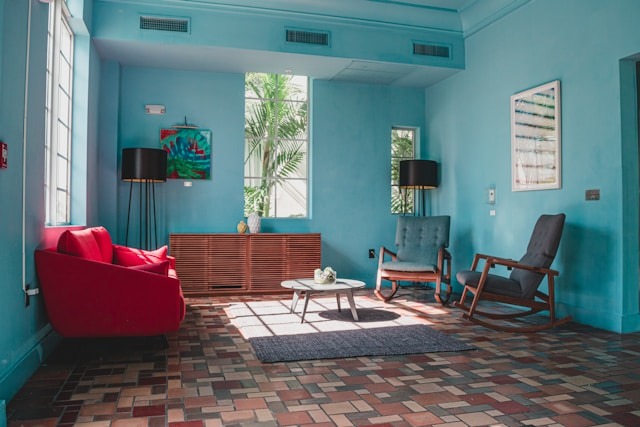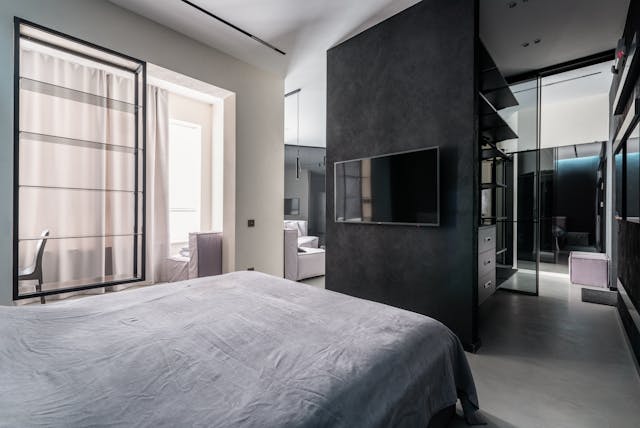Color psychology reveals that room colors greatly influence your mood. Red infuses energy and passion, making it ideal for social spaces. Conversely, blue hues evoke tranquility and boost concentration, perfect for work or relaxation areas. Yellow brightens up a room with joy and creativity, excellent for kitchens or offices. Green provides a peaceful backdrop, reducing stress in living areas or bedrooms. Orange bursts with liveliness, revitalizing home gyms, while purple offers calmness and sparks creativity. Even white and black play roles, promoting purity and sophistication. Each color has the power to transform your space and mood, unveiling secrets to your emotional well-being.
Key Takeaways
- Different colors in a room can significantly influence one’s mood and behavior.
- Red energizes and elevates mood, making it ideal for social areas.
- Blue tones lower stress and improve sleep, promoting tranquility and mental well-being.
- Yellow adds brightness, uplifting moods and fostering creativity in spaces.
- Green offers a calming backdrop, reducing stress and promoting serenity and balance.
Understanding Color Psychology
Color psychology explores how different shades can greatly impact your mood and behavior. It’s not just about aesthetics; the colors you surround yourself with in a room can notably influence how you feel. Delving into the world of color psychology provides you with the tools to make informed decisions about the colors you choose for your living spaces, ensuring they contribute positively to your mood and overall well-being.
For instance, consider blue, one of the most calming shades in the spectrum. Integrating various shades of blue into a room can create a serene and tranquil atmosphere, ideal for relaxation and stress reduction. This color’s psychological effects are so profound that it’s often used in bedrooms and bathrooms to promote a peaceful environment. It’s not just about picking a color because you like it; it’s about understanding how that color makes you feel and how it can alter the mood of a room.
Reds Emotional Impact
Often, red energizes a room, instantly elevating mood and sparking dynamic conversations. This vibrant hue doesn’t just catch your eye; it plays with your body’s responses, raising blood pressure, respiration speed, and heart rate. This biological uptick boosts your energy levels, making you more prone to engage, debate, and share. It’s why red finds its way into dining rooms and entertainment areas, spaces where lively atmosphere and stimulated conversation are key.
Red’s ability to evoke passion, excitement, and a sense of power makes it an ideal choice for areas designed for social interaction. Imagine walking into a room bathed in red; the color creates a strong, unforgettable first impression, especially in entryways. And when the sun sets, and lamplight takes over, red transforms into a rich, elegant backdrop, perfect for evenings filled with deep, meaningful conversations or vibrant, joyous gatherings.
Choosing red for your space means embracing boldness and attention to detail. It enhances a room’s energy and visual impact, making any gathering more memorable. Whether you’re dining, debating, or simply enjoying the company, red guarantees the atmosphere is charged with an undeniable, passionate energy.
The Calm of Blue Tones
You’ve likely felt the calm wash over you when stepping into a room bathed in blue. It’s not just your imagination; blue hues can greatly lower your stress and improve your sleep quality. If you’re aiming for a space that boosts focus and tranquility, incorporating various shades of blue might just be your best bet.
Blues Soothing Effects
Throughout the day, surrounding yourself with blue tones can greatly enhance your sense of calm and relaxation. Delving into room color psychology reveals that shades of blue have a profound calming effect on the mind and body. Research supports this, showing that blue hues can lower blood pressure and heart rate, ushering in tranquility. Opt for lighter shades of blue in spaces like bedrooms or meditation areas to maximize this relaxing color’s benefits. Blue’s versatility means it’s not just about calmness; it brings a subtle cheerfulness to any room without overwhelming the senses. By integrating blue into your environment, you’re not only creating a serene space but also promoting a healthier, more peaceful lifestyle.
Enhancing Focus With Blue
Drawing on blue’s calming effects, this hue can greatly enhance your focus and productivity in environments where concentration is key. Lighter shades of blue, in particular, foster a serene environment that’s pivotal for stress reduction and bolstering concentration. The versatility of blue makes it a prime choice for bedrooms, offices, and study areas, aiming to evoke tranquility and mental clarity. Its calming influence is essential for maintaining calmness and composure through demanding tasks, ensuring you’re at your cognitive best. By incorporating blue tones in your decor, you create a peaceful ambiance that’s conducive to deep focus and stellar cognitive performance. It’s not just about aesthetics; it’s about creating a space that genuinely supports your mental well-being and productivity.
Blue and Sleep Quality
Incorporating blue tones in your bedroom can greatly enhance your sleep quality by promoting a sense of calmness and relaxation. Research backs the idea that blue hues not only promote relaxation but also lower heart rates and reduce blood pressure, setting the stage for a deeper, more restorative sleep. It’s the tranquility and serenity associated with blue that crafts a soothing environment, especially when you opt for light shades of blue. These lighter tones are particularly adept at inducing calmness, prepping your mind to drift off into sleep more easily. By integrating blue elements into your bedroom decor, you’re basically crafting a peaceful atmosphere that improves sleep quality. So, consider giving your bedroom a serene blue makeover to reap these restful benefits.
Yellow: Brightness and Energy
Yellow, with its inherent brightness and energy, instantly imbues any room with a sense of happiness and joy. This vibrant hue is a powerhouse of positivity, lighting up spaces with its cheerful glow. When you splash your walls with yellow, you’re not just choosing a color; you’re setting the stage for an atmosphere brimming with optimism and warmth.
Yellow reflects light superbly, making any area feel more alive and inviting. It’s the perfect choice for rooms where you need a boost of energy and focus, such as kitchens, offices, and playrooms. Here, yellow works its magic, fostering an environment where creativity and productivity flourish.
- Varying shades evoke different vibes: From soft, buttery hues that calm to bright lemon tones that energize, yellow’s versatility is unmatched.
- Uplifts moods: On gloomy days, yellow is a ray of sunshine, uplifting spirits and promoting happiness.
- Promotes optimism: Surrounded by yellow, you can’t help but feel a sense of hope and anticipation for the future.
Incorporating yellow into your decor is more than a design choice; it’s a commitment to fostering an environment of joy, energy, and boundless positivity.
Green for Serenity
Green invites a sense of serenity into your space, offering a calming backdrop that helps reduce stress and anxiety. Known for its ability to promote serenity and a sense of balance, green transforms any room into a refuge of tranquility. It’s not just a color; it’s a nod to nature, growth, and renewal, which brings a revitalizing touch to your surroundings. Imagine the peaceful atmosphere green creates, ideal for those moments when you need to unwind and find your center.
Incorporating green into your living areas or bedrooms, where relaxation is paramount, can greatly elevate the sense of calm. Whether it’s through a painted wall, lush houseplants, or subtle green accents, these elements work together to forge a peaceful and harmonious atmosphere. The connection between green and nature is undeniable, and bringing this color into your home is like opening a door to the outdoors, inviting in a slice of the natural world’s inherent tranquility.
Let green be your ally in creating a space where relaxation reigns supreme. Its power to reduce stress and foster a sense of harmony makes it an ideal choice for anyone looking to craft a more peaceful, serene living environment.
Oranges Vibrancy Effect
While green brings tranquility, introducing orange into your space adds a burst of energy and vibrancy, perfect for areas where enthusiasm and activity are desired. Orange, with its radiant hue, naturally evokes a sense of excitement and enthusiasm. It’s no wonder that it’s the go-to color for spaces like home gyms or exercise rooms, where you’re looking to energize and motivate yourself.
Yet, it’s important to remember that orange’s intensity can be overwhelming, especially in areas meant for relaxation. Here’s how you can make the most out of this vibrant color:
- Use orange as an accent color to inject a dynamic touch without overpowering the room. Think throw pillows, rugs, or artwork.
- Incorporate orange in areas where a pop of color can uplift the mood and create an inviting, lively atmosphere.
- Limit the use of orange in calming spaces to maintain their tranquility.
In essence, orange brings an unparalleled energy to any room. By using it thoughtfully, you can enjoy the vibrancy and warmth it adds to your home, making it a source of inspiration and joy.
The Tranquility of Purple
You’ve probably noticed how the color purple brings a sense of calm to any space. It’s not just about aesthetics; purple’s ability to enhance creativity while soothing the mind is unmatched. By incorporating purple into your decor, you’re not just making a style statement, but inviting tranquility and inspiration into your room.
Purples Calming Effects
Purple’s calming effects can swiftly transform any room into a sanctuary of tranquility, promoting peace and creativity. Known for its association with spirituality, luxury, and the ability to inspire, purple brings a versatile charm to any space. It’s not just about aesthetics; the color has a profound impact on your mental state, helping to reduce stress and anxiety. As you bask in the serene atmosphere it creates, you’ll notice a significant boost in your mental clarity.
- Lighter shades of purple foster serenity and a welcoming ambiance, perfect for relaxation zones.
- Incorporating purple in decor can strikingly enhance the mood, promoting balance and harmony.
- Its soothing nature makes it an ideal choice for bedrooms, study areas, and places meant for meditation and reflection.
Enhancing Creativity With Purple
Capturing the peaceful essence of purple can awaken your creative potential, nurturing an atmosphere where innovation flourishes. Purple’s deep symbolism of luxury, wealth, and power transcends to a domain where creativity and royalty intersect. This color doesn’t just decorate your space; it transforms it into a haven of peace, ready for introspection and innovative thinking. Envision incorporating purple accents into your workspace. Suddenly, the room isn’t just a space; it’s a cradle for artistic expression, a sanctuary where your imagination wanders freely. Purple’s unique ability to inspire imagination and improve problem-solving skills is undeniable. So, if you’re craving a surge of creativity or a solution to a persistent problem, let purple’s tranquil vibe lead your mind towards unexplored territories of innovation and creativity.
Navigating White and Black
When considering room colors, understanding the subtleties between white and black can greatly impact your space’s mood and aesthetic. White isn’t just white; it’s a palette of shades that can evoke a range of emotions, from the purity of a fresh snowfall to the sleekness of modern design. Lighting plays an important role here, with natural light bringing out the best in these shades, making spaces feel larger and more inviting.
Black, on the other hand, brings its own set of characteristics. It’s the go-to for adding a touch of sophistication and mystery, creating dramatic accents that draw the eye and command attention. Yet, tread lightly; too much black can overpower and make a room feel smaller or overly somber.
Here are a few tips to navigate these colors in your space:
- Pair white with gray for a touch of classic elegance that softens the starkness while still keeping the space bright and airy.
- Use black as an accent color to inject drama and depth without overwhelming the room.
- Consider the room’s lighting, especially natural light, to enhance the characteristics of white and black, ensuring they complement rather than compete with each other.
Frequently Asked Questions
How Do the Colors of Rooms Affect Mood?
Room colors have a profound impact on your mood through color symbolism, lighting, and personal preferences. They evoke emotional reactions, influenced by cultural interpretations, age, and seasonal effects, enhancing psychological comfort in spaces tailored to your needs and desires.
What Color Is Best for Bedroom Color Psychology?
For your bedroom, go for peaceful greens or soothing purples to promote relaxation. Cooling blues also work wonders for a calm atmosphere. Avoid vibrant reds and energizing oranges, which might disrupt your sleep.
Does the Color of a Room Affect Human Behavior Project?
Yes, the color of a room can affect human behavior. Color experiments and behavioral studies reveal significant psychological impacts and emotional responses, influenced by cultural perceptions, design principles, lighting, and environmental psychology insights.
How Color Effects a Room?
Color trends, lighting, and texture influence your room’s vibe, impacting your mood and energy. Perception, cultural significance, age preference, and seasonal variations play roles, shaping your space’s identity and how you feel in it.
Conclusion
So, you’ve seen how colors touch every corner of our emotions, from the energizing spark of red to the soothing embrace of blue. Yellow injects your space with sunshine, while green brings in nature’s calm. Orange’s zest stirs excitement, and purple wraps you in tranquility. Even in the stark contrasts of white and black, there’s a balance to find. Remember, your room’s palette isn’t just about looks; it’s a tool to shape your mood. Choose wisely, live vibrantly.








